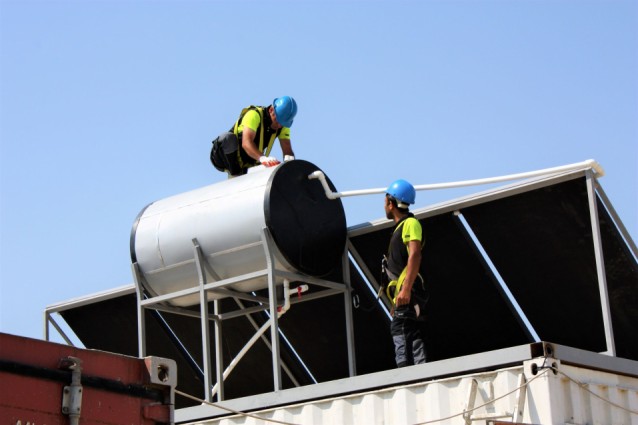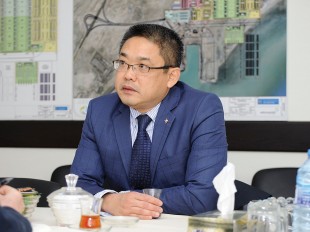 Knut-Erlend Rosvold stands next to a roof-top solar array that Provitaz installed in Baku. Photo: courtesy of Knut-Erlend Rosvold
Knut-Erlend Rosvold stands next to a roof-top solar array that Provitaz installed in Baku. Photo: courtesy of Knut-Erlend Rosvold
Last summer, Azerbaijan faced the worst series of blackouts since the collapse of the Soviet Union. During a streak of abnormally hot weather in early July, a fire broke out at the thermal power plant at Mingachevir, which was followed by the collapse of the nation’s power grid. This catastrophic loss of power shut down water treatment facilities, leaving homes without running water, and shut down the Baku metro, trapping thousands of people underground until rescuers were able to lead them out of the tunnels on foot.
President Ilham Aliyev ordered a commission to fully investigate the cause of this multi-day event. Later, the blackouts were officially blamed on the fact that the aging Mingachevir plant was in a state of disrepair, and charges of criminal negligence and abuse of power were being investigated. In the wake of all of this, the nation’s electricity supply became one of the hottest topics of conversation in Azerbaijan last summer.
Coincidentally, I had already planned to meet with Knut Rosvold, the owner of Provitaz, a Lenkeran based alternative energy company, to learn more about the alternative and renewable energy situation in the country. Traffic was at a slow crawl that morning, and sweaty Bakuvians who seemed to still distrust the metro were crammed particularly thick onto buses. As I extracted myself from the number 18 and approached our meeting spot, I saw Knut’s light brown beard through the side window of his car. Being from Norway, he had his air conditioner cranked on high, and I was grateful for the reprieve from the 9am sun. After a few pleasantries, we set off towards the edge of Baku where Provitaz was in the middle of an installation project.
The nation's electricity supply became one of the hottest topics of conversation in Azerbaijan last summer
As we drove, I inquired about the name of his company. He explained that it is actually a three-part word he made up himself coming from the Latin “pro vita,” meaning “for life,” and “az” for Azerbaijan. To me, it had the ring of a toast to the health of the nation. I then asked Knut his thoughts on the recent blackout: This is what happens as people get a higher standard of living and get used to comfort, he said. They turn on the A/C when it gets hot, because they bought it and want to use it.
His theory, he told me, is that in recent years air conditioners have become cheaper and more widely available in Azerbaijan, and the number of people buying them has drastically increased. Suddenly, a heat wave arrives and everyone in the country turns on their air conditioners at the same time, which can overload the power grid. This, coupled with the poor state of the Mingachevir power plant, meant the situation was ripe for a blackout.
All this lines up with a statement found on President Aliyev’s website, president.az: The voltage transformer of a substation of Mingachevir Thermal Power Station broke on the night of July 2 to 3 due to the excessive use of electricity by the population caused by an abrupt change in weather conditions and increase in temperature to a high limit.
Alternative energy for Azerbaijan
I knew that one of Provitaz’s main focuses is solar energy, so I asked how that fits into the country’s energy situation: It can make micro grids on houses and [industrial buildings] and they can in a quick way reduce the load on the grid... It will be an investment that will be beneficial to business. It serves their pocket, but it also serves the nation.
Knut explained that the nature of solar means that you can set up a miniature power grid that provides electricity just for one building or for a set of buildings. It can be scaled in a way to reduce electricity used from the main grids during peak hours, such as by angling the solar panels to collect the most sunlight during these high-use hours, and coupling this with battery storage to run air conditioners in the evenings after the sun has set. Many Western countries allow people to sell the extra energy they produce back to the main grid, both profiting them financially and providing more clean energy to other users. For this to occur in Azerbaijan, though, new legislation along with financial and tax incentives would first need to be agreed upon. While it hasn’t happened yet, it may not be a far-off reality. Azerbaijan has already been pushing the idea of alternative and renewable energy for a number of years.
In 2015, Jamil Melikov, the deputy head of Azerbaijan’s Agency for Alternative and Renewable Energy (AFARE), spoke about this, suggesting that by increasing alternative energy consumption domestically the country would be able to export more of its oil and gas:
This requires high-tech solutions, and Azerbaijan is going to gradually introduce them. Achieving this goal, we will increase the country’s export potential. In particular, Azerbaijan will be able to send more hydrocarbons for export, reducing domestic consumption. It is also very important from an environmental point of view.
There will come a time, even for energy giants like Azerbaijan, when the gas runs out, or when earthquakes and other events disrupt gas supply, especially in rural areas, and other options will be needed
The country is in a great position to harness alternative and renewable sources of energy. Anyone who has spent any time in Baku understands why its name means “wind-pounded city.” Nearly every day of the year, gusts of up to 140 km/h buffet the Absheron and other parts of the country, and the desert and semidesert environments of Azerbaijan have no shortage of sunshine. Along with its huge potential for wind and solar energy, efforts have also been launched to increase hydroelectric, geothermal and biogas energy production. Together, experts estimate that these sources give Azerbaijan a potential 12,000 megawatts of renewable energy.
Large-scale efforts to harness this are already under way. Driving away from Baku along any of the major highways, one can see solar and wind installations of various sizes. Along with this, companies like Provitaz seek to bring alternative energy directly to customers in a number of innovative ways.
Exploring the options
As we arrived at our destination, I got to see my first example up close and in person. I stepped out of Knut’s car and took a look at the shipping container sitting in front of me. Inside, I saw a toilet, sink, and shower stalls. On top, two men in construction hats were fastening black panels to the roof. As I looked more closely, I realized that they didn’t look like other solar panels I had seen. Workers from Provitaz install a solar water heater on a shipping container to be used as a portable restroom. Photo: David Maximovich
Workers from Provitaz install a solar water heater on a shipping container to be used as a portable restroom. Photo: David Maximovich
It’s a solar water heater, Knut explained. A special panel with black tubing and a glass front traps solar heat inside and can reach temperatures of 140-150 degrees Celsius. This heats the water in the tubes, which causes it to rise out a pipe in the top and go back out into a holding tank. This creates a sort of natural circulation in the water, which causes the cooler water at the bottom of the tank to be pulled into a lower pipe, where it then goes into the panel to be heated again.
This particular shipping container was being retro-fitted for a customer into portable showers for sporting events and construction crews. Equipped with both solar hot water and solar electricity, they could take a fully functioning modern bathroom anywhere in the country.
Most people have heard of solar electricity, but not solar hot water, Knut said. We conducted a survey, and only five per cent of the people surveyed had heard of solar hot water, but 70 per cent had heard of solar electricity. Aside from providing a hot shower, solar hot water can also be used to heat homes, and in any other industrial or agricultural setting where traditional hot water would be used. One area Azerbaijan could apply this and see quick benefits would be in the tea industry, where water must be slightly heated before being introduced to plants through drip irrigation.  Woodfire commercial ovens in the Lenkeran area are capable of baking over 1,000 loaves of bread a day while using 70 per cent less wood than traditional tandir ovens. Photo: courtesy of Knut-Erlend Rosvold
Woodfire commercial ovens in the Lenkeran area are capable of baking over 1,000 loaves of bread a day while using 70 per cent less wood than traditional tandir ovens. Photo: courtesy of Knut-Erlend Rosvold
Another source of renewable energy that is often overlooked is biomass. This typically takes the form of wood but can also include certain types of agricultural residue and household waste. At first glance, this doesn’t make sense. Cutting down trees and burning trash aren’t exactly what come to mind when thinking of clean alternative energy. One must remember, however, that the carbon stored in biomass is part of the natural carbon cycle, whereas carbon from fossil fuels is not, so even though gas burns cleaner than wood, it is adding carbon into what would have been a closed cycle. Biomass burning can be made cleaner if it is done more efficiently, and it doesn’t add new carbon into the system. Plus biomass, unlike fossil fuels, is renewable. There will come a time, even for energy giants like Azerbaijan, when the gas runs out, or when earthquakes and other events disrupt gas supply, especially in rural areas, and other options will be needed.
Provitaz believes that one solution lies with the Kuznitsov Stove. This innovative design, created by Russian engineers, allows better airflow within the furnace, which increases the temperature inside and more completely burns the biomass. It gives a higher energy output than other biomass burners and can be used to heat homes and water and cook with all at the same time. On a commercial scale, these ovens are already being employed by a few bakeries in the Lenkeran area.
Seeing the light
Knut pointed out that being a more energy efficient country doesn’t just mean utilizing sources of alternative energy. Energy consciousness means being aware of both where the energy is coming from and where it is going. Huge amounts of energy literally fly right out the window in the form of heating and cooling. Some sources state that in developed countries like the US, where buildings tend to have better insulation, this takes up an average of 48 per cent of a typical energy bill. One way this can be combatted is through better design. Passive solar heating, which involves angling windows to face the sun during certain seasons and times of the day, as well as strategic shading and venting, can drastically affect building temperature. Another strategy is using building materials with better insulating properties.
More and more businesses and individuals are starting to see that alternative energy is a win-win-win situation
Unfortunately, just as few people in Azerbaijan are aware of the potential of solar hot water, these design innovations and modern building materials remain largely unknown and unutilized. The country’s push to see Azerbaijan become a more energy efficient nation will likely change this however. Its leadership is aware that it cannot rely on oil and gas forever. Strides are being taken to diversify the economy and move away from domestic oil and gas dependency. More and more businesses and individuals are starting to see that alternative energy is a win-win-win situation. It helps improve the overall energy and economic health of the country, it reduces impact on the environment, and it positively impacts one’s wallet as well.
As Knut and I drove away from his project site, he told me of various local companies who are already seeing the light. As they choose alternative energy, they are paving the way for a brighter future for Azerbaijan, both figuratively and literally and events like the July 2018 blackouts will soon become things of the past.




